Try this fail-proof homemade mayo recipe! With just a handful of ingredients, you can make creamy mayonnaise from scratch in less than 10 minutes.

If you’ve never tried homemade mayo before, you’re in for a culinary awakening! Ever since I’ve started using this mayonnaise recipe, I haven’t gone back to store-bought. Homemade mayonnaise is rich, ultra-creamy, and way more flavorful, and it’s SO simple to make using an immersion blender. You can use this mayo in all of your favorite recipes, from salads to dressings to dips, or spread it over your next sandwich. Anything store-bought mayo can do, homemade mayo does better!
Why You Should Make Mayo at Home
- Fail-proof. Using a whole egg rather than just the egg yolk cuts down on time (there’s no need to separate the eggs!) and also makes for more stable homemade mayo.
- Easy ingredients. Chances are that you have everything you need to make mayonnaise in your fridge and pantry already. You can also customize this recipe with easy add-ins to make flavored mayos and aiolis. I share some of my favorite ideas later on.
- Quick. Making mayo at home takes all of 10 minutes and you can keep it stored in the fridge for days.
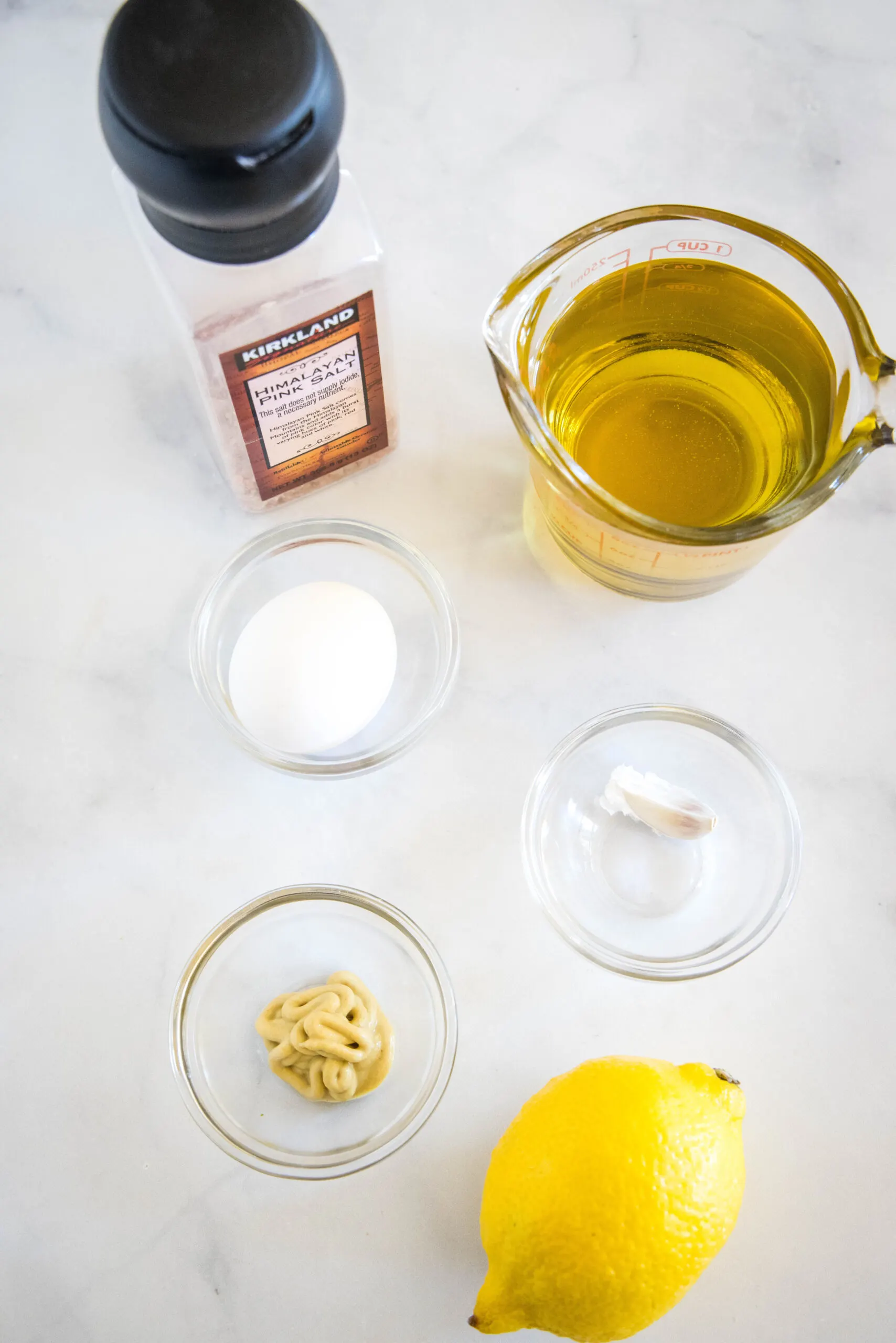
Ingredients You’ll Need
Here’s a quick overview of your homemade mayonnaise ingredients. You likely have them in your kitchen already! Be sure to scroll to the recipe card for a printable ingredients list and recipe instructions.
- Egg – Homemade mayo calls for one whole, raw egg. I’ve never had any issues using raw eggs in this recipe, however, if you’re worried about it, I recommend buying pasteurized eggs. These are eggs that have been heated to a high enough temperature to kill bacteria like Salmonella. You’ll find pasteurized eggs alongside the other eggs in the grocery aisle.
- Mustard – Dijon mustard is an emulsifier that acts as a safeguard against broken mayonnaise in this recipe. You can use regular yellow mustard if that’s what you have on hand. You can make mayo without mustard, too, but it comes with a higher chance of breaking.
- Lemon Juice – Or wine vinegar. The acidity helps to stabilize the mayo and also adds flavor.
- Garlic – A freshly minced garlic clove adds an extra layer of flavor, but feel free to skip it or use ¼ teaspoon of garlic powder if you prefer.
- Oil – The best oil to use for homemade mayonnaise is a refined, neutral-flavored oil, like avocado oil that’s light in flavor. Canola oil, sunflower oil, and grapeseed oil are other good options. Unrefined oils (ie, extra virgin olive oil) aren’t a great choice as the spicy, robust taste can be a bit overpowering. You can try mixing olive oil with another mild-flavored oil if you’d like.
How to Make Homemade Mayonnaise
When it comes to making mayonnaise at home, the easiest method is to use the immersion blender. A food processor with a small bowl will also work. You can make it by hand with a whisk, too, but expect very tired arms if you do!
I make this homemade mayo using my immersion blender. It’s super quick. You’ll find the printable instructions if you scroll to the recipe card, but here’s how easy it is:

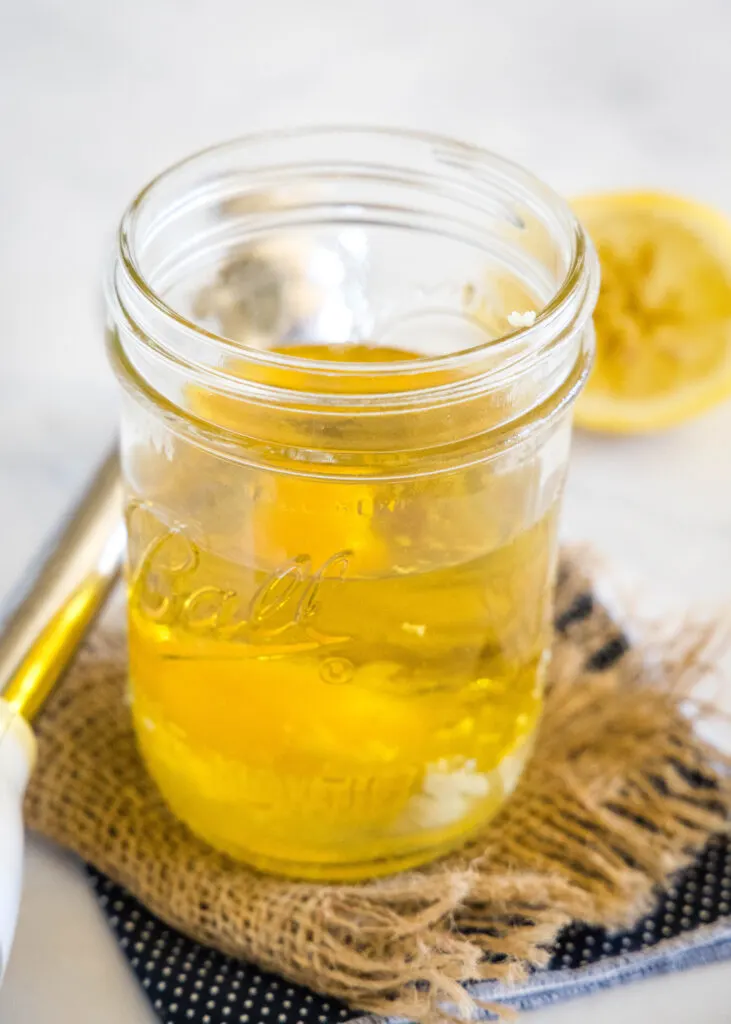
- Combine the ingredients. First, add an egg, lemon juice, and mustard to a jar or glass with garlic and oil. Let the mixture rest and mingle for a minute.
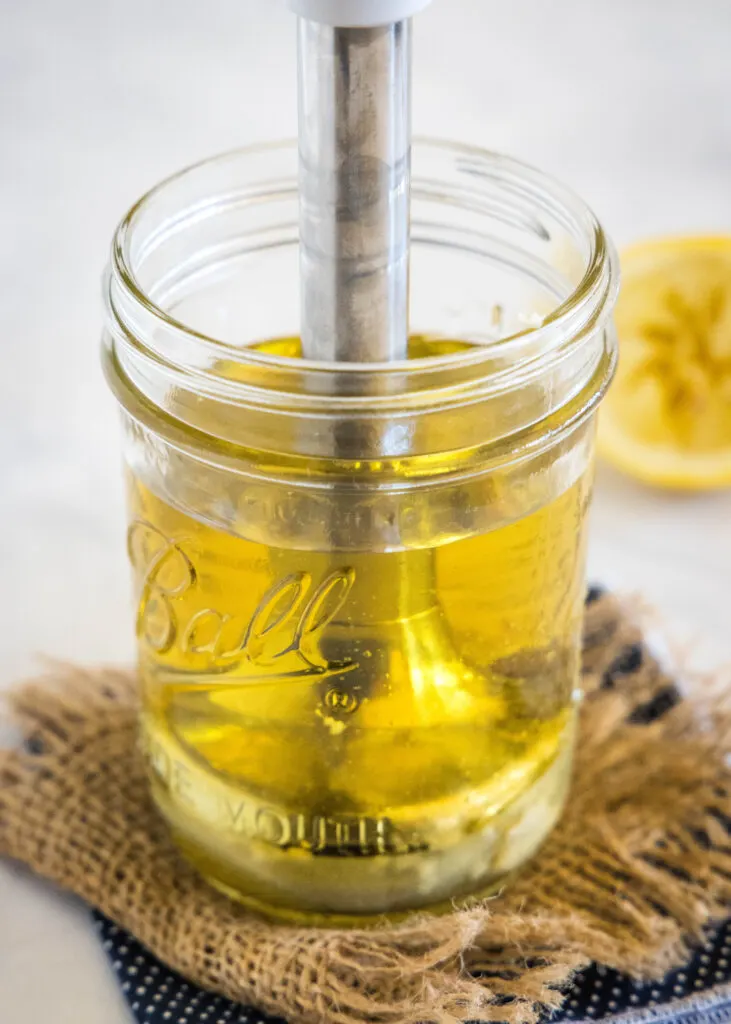
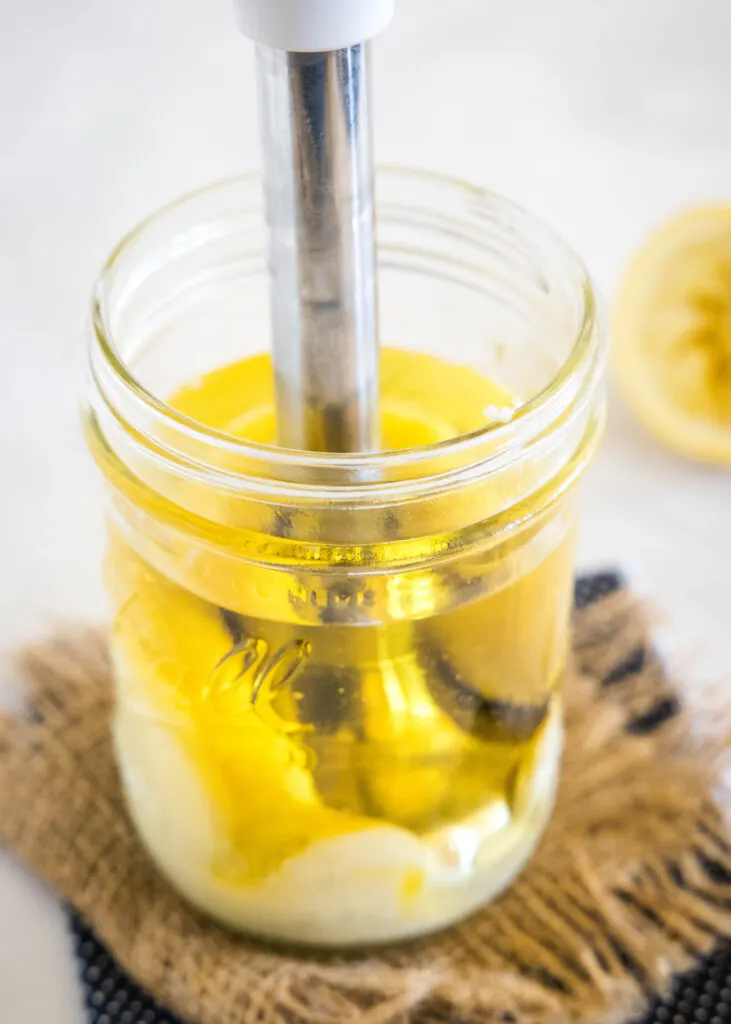
- Blend. Process the mixture using your immersion blender. The mayo will start to emulsify. As it does, tilt the blender wand and bring it higher in the jar to make sure that everything gets well blended.
- Done! After a minute or so, you’ll have mayonnaise (how easy was that?!). Taste and adjust the seasoning and lemon juice if needed. Then, cover and store your homemade mayo in the fridge, and get spreading.
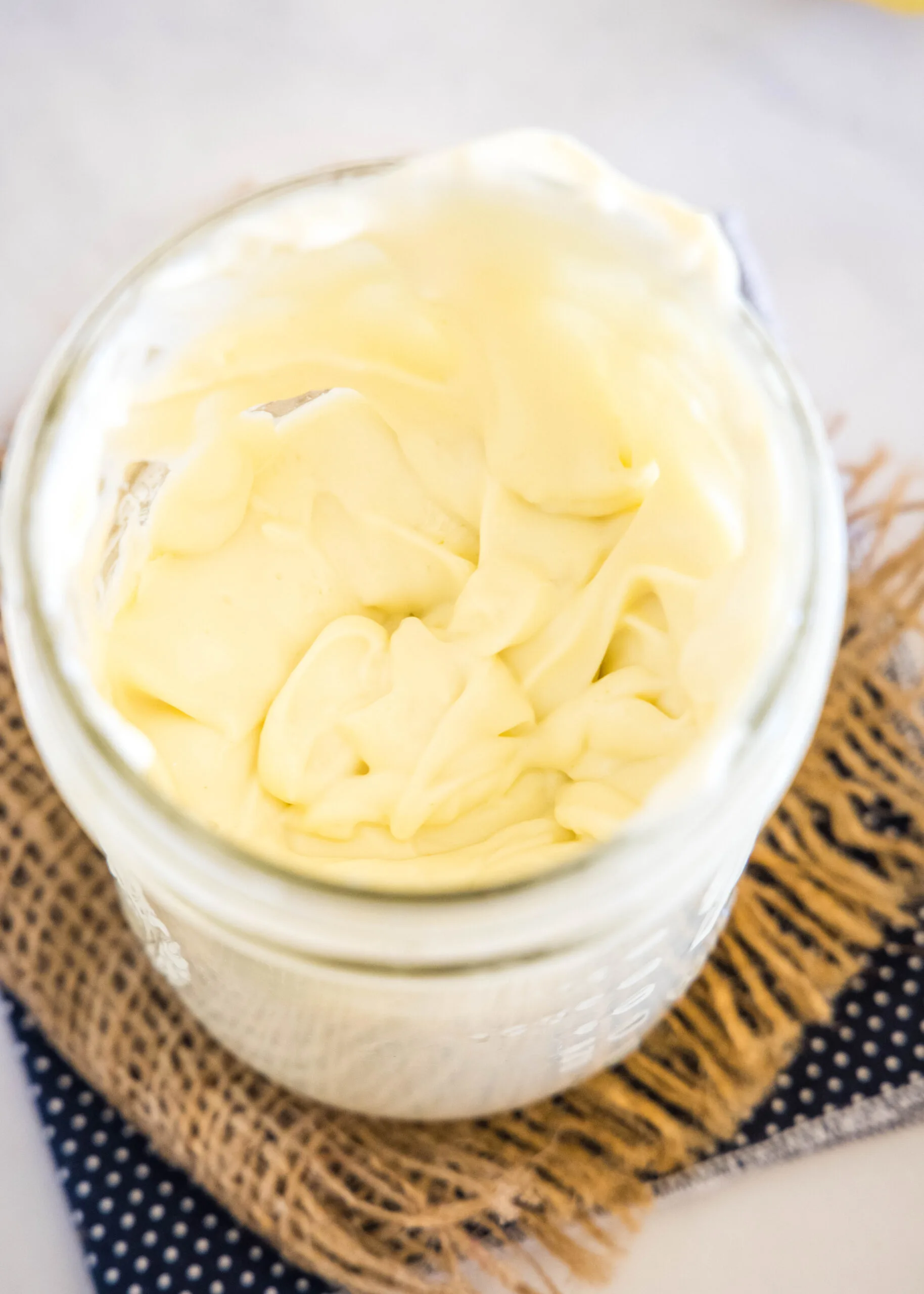
Recipe Tips
Here are my top tips to make this homemade mayo a success story:
- Use the right glass. The jar you use to make mayo should be wide enough for the immersion blender to fit into, and narrow enough that the ingredients reach the blades. This ensures that the mayo will fully emulsify. If the egg, mustard, and lemon juice fall short of the blender blades, double the recipe. (The more, the mayo-ier?)
- Use room temperature ingredients. This mayo recipe works best when all of the ingredients are at the same temperature. Take your eggs out of the fridge ahead of time, or you can submerge cold eggs in lukewarm (not hot) water for a couple of minutes to speed things up.
Mayonnaise Variations
This homemade mayo is delicious and classic and tastes so fresh when you make it yourself! If you’d like to build on the flavors, try making homemade garlic aioli (you can also use roasted garlic). Or, add your choice of fresh chopped herbs (rosemary, thyme leaves, parsley) or curry powder. You can also add Cajun spice to make a spicy Cajun dipping sauce, or hot sauce, like Sriracha, for homemade spicy mayo.

How Can I Fix Broken Mayonnaise?
So, you’ve blended your mayonnaise, when all of a sudden it looks curdled and split, and not creamy at all. Before you panic: it’s likely fixable! Broken mayo is a rare worst-case scenario with this recipe, but your mayo isn’t a total write-off if it happens.
I’ve done my best to make this homemade mayonnaise 100% fail-proof (using a whole egg and mustard helps in this regard). But, if your mayonnaise breaks, there are a couple of things that you can do to try and fix it:
- Use mustard. Start with about a teaspoon of mustard in a separate bowl. Gradually beat the broken mayo into the mustard, a little at a time. Since mustard acts as an emulsifier, you should start to see your mayo turn creamy again.
- Use an egg yolk. Add an egg yolk (only the yolk) to a bowl. Following the same instructions as the mustard, whisk the broken mayonnaise into the yolk a small amount at a time until the texture is creamy.
Frequently Asked Questions
Is it safe to use raw eggs in homemade mayo?
Eggs are an essential ingredient in mayonnaise. Most risks associated with using raw eggs are low, but if you’re concerned, buy pasteurized eggs, and eggs that have been refrigerated. Don’t use dirty eggs, or eggs that show signs of cracks or damage. The CDC offers more guidance on reducing the risks of using eggs.
Can I use olive oil to make mayonnaise?
Yes, you can use olive oil. However, keep in mind that using a strongly flavored extra virgin olive oil will impart that flavor to your mayo. If you’d like to use olive oil, I recommend using a blended oil (ie, olive oil mixed with another vegetable oil), or replacing only half of the neutral-flavored oil with a light, fruitier olive oil that has a milder taste.
How do you thicken homemade mayonnaise?
If your mayonnaise breaks or refuses to thicken, all is not lost. See my tips above on how to fix mayo that’s broken or runny, and give those a try.
How long does homemade mayonnaise last?
As a general rule, homemade mayo lasts as long as the eggs would last. Properly stored, this recipe will keep in the fridge for up to 1-2 weeks depending on how fresh your eggs are. You’ll find more details on storage below.
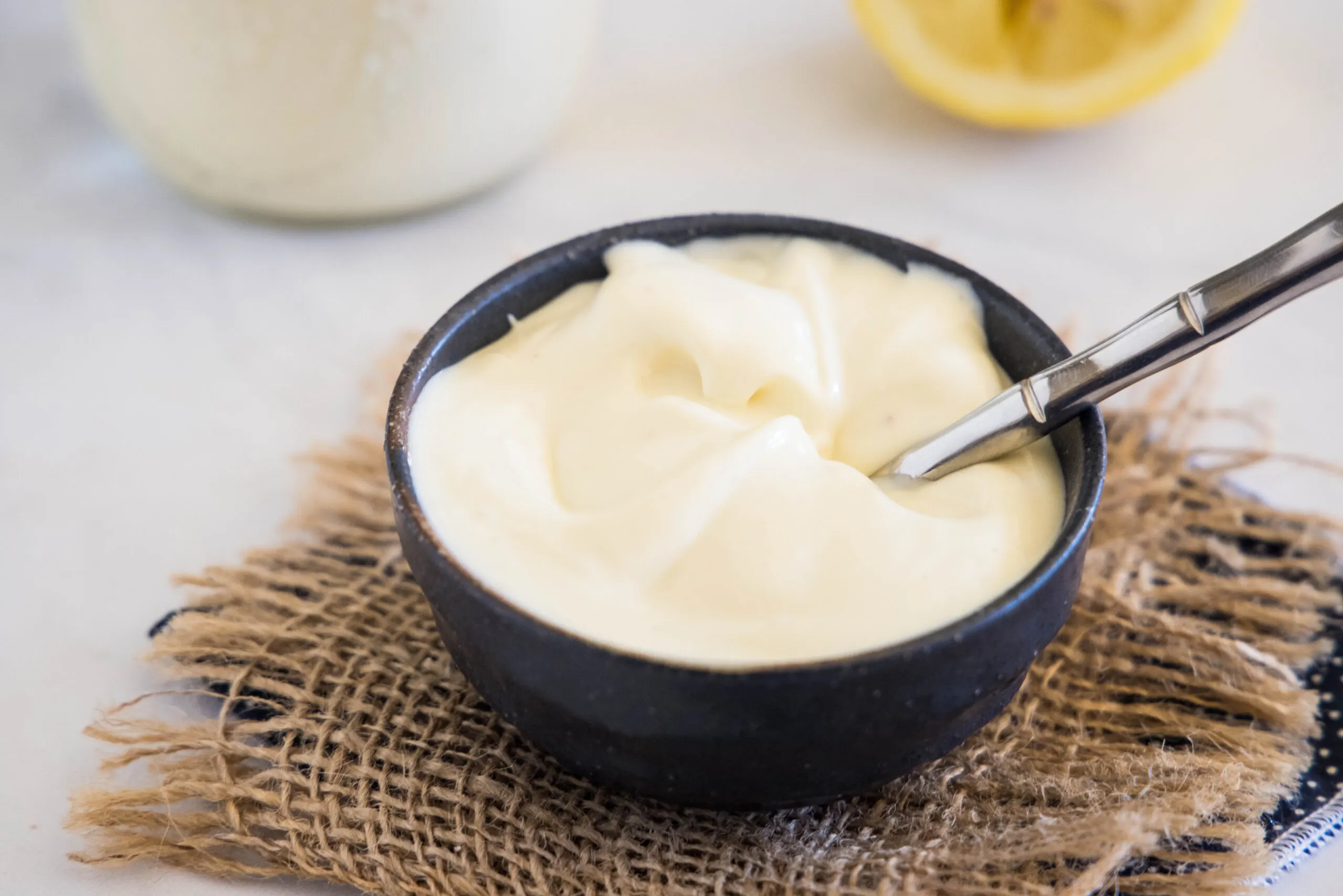
Ways to Use Homemade Mayonnaise
I can’t wait for you to try this fresh homemade mayo. Of course, you can’t go wrong spreading it over a turkey club sandwich or a crispy chicken sandwich. But there are plenty of ways to use mayonnaise that goes beyond sandwiches, too! Try these ideas:
How to Store
Keep your homemade mayonnaise covered tightly in the fridge for up to 2 weeks. Note that your mayo may not last quite as long if your eggs aren’t super fresh to start with.
Can I Freeze Mayonnaise?
Mayonnaise is an emulsion, meaning it combines ingredients that wouldn’t normally mix into a rich and creamy sauce. Freezing and thawing causes the emulsion to break, and the texture just isn’t the same after. I’ll always recommend making a fresh batch whenever possible. Luckily, all it takes is a few minutes!
More Homemade Condiments and Sauces
Prep Time 5 minutes
Total Time 5 minutes
Ingredients
- 1 whole large egg
- 1 Tablespoon Dijon mustard
- 1 Tablespoon lemon juice
- 1 clove garlic, minced
- 1 cup avocado oil (or other neutral oil)
- ½ teaspoon salt
Instructions
- Using a large mouth jar or glass (you want something that the immersion blender can just fit into) add the egg, lemon juice and mustard. Test that putting the immersion blender in the ingredients come up to the blades (this will ensure it fully emulsifies).
- Remove the blender, add the garlic and pour in the oil. Let the mixture set for 1 minute to slightly combine before blending. Add your immersion blender, and process on high. Once the mixture starts to emulsify, gently tilt the blender to the side and slowly rise to the top to fully blend everything together. This process should take about 1 minute.
- Cover and store in the fridge for up to 2 weeks.
Notes
- Don’t have an immersion blender? Use a small food processor or a food processor that has a small bowl insert. If the egg, lemon juice, and mustard do not reach the blades before adding the oil, double the recipe.
Nutrition Information
Yield
8Serving Size
1Amount Per Serving Calories 252Total Fat 28gSaturated Fat 3gTrans Fat 0gUnsaturated Fat 23gCholesterol 23mgSodium 163mgCarbohydrates 0gFiber 0gSugar 0gProtein 1g
Nutrition Disclaimer: All information presented on this site is intended for informational purposes only. I am not a certified nutritionist and any nutritional information shared on dinnersdishesanddesserts.com should only be used as a general guideline.
I created a fun group on Facebook,and I would love for you to join us! It’s a place where you can
share YOUR favorite recipes, ask questions, and see what’s new at Dinners, Dishes and Desserts (so that you never miss a new recipe)!
Be sure to follow me on Instagram and
tag #dinnersdishes so I can see all the wonderful DINNERS, DISHES, AND DESSERTS
recipes YOU make!
Be sure to follow me on my social media, so you
never miss a post!
Facebook | Twitter | Pinterest | Instagram
Did you know there is a Dinners,
Dishes, and Desserts SHOP? Lots of different E-Books for sale. Or you can buy me a
coffee to say thanks!
.
OTHER RECIPES YOU MIGHT LIKE:
Discover more from reviewer4you.com
Subscribe to get the latest posts to your email.





